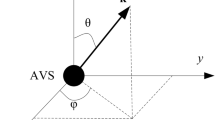Abstract
A new signal processing method using a single vector hydrophone is proposed for solving the problem of azimuth angle estimation for multiple targets based on a small aperture underwater platform. The method extends the aperture from a single vector hydrophone into a half wavelength distance uniform linear array by decomposing the time-domain sample data from different channels of the hydrophone. The extended array has a narrower space beam pattern than a single vector hydrophone. The azimuths of spatial multiple targets are estimated by using the appended array snapshots under the condition of broadband or narrow band signals. The new method is robust because there is no need to correct the array manifold. Theoretical analysis and computer simulations show that, the new algorithm has the ability to distinguish two incoherent targets with either narrow band or broadband signals in an isotropic noise field. The algorithm provides a non-biased estimate with a high signal-to-noise ratio.
Similar content being viewed by others
References
Jemmott C W, Culver R L. Single-hydrophone model-based passive sonar source depth classification. IEEE J Ocean Eng, 2011, 36: 696–702
Lee Y P. Time-domain single hydrophone localization in a real shallow water environment. In: OCEANS’98 Conference Proceedings, Nice, 1998. 1074–1077
Yang S E. Method of multi-sources distinguishing by single vector transducer (in Chinese). J Harbin Eng Univ, 2003, 24: 591–595
Gu X D, Qiu Z M. ESPRIT algorithm for DOA estimation using a single vector hydrophone (in Chinese). J Harbin Eng Univ, 2009, 30: 867–871
Kumaresan R, Tufts D W. Estimating the angle of arrival of multiple plane waves. IEEE Trans Aerosp Electron Syst, 1983, AES-19: 134–139
Chen S H, Chen C, Zheng W. Multi-sources distinguishing by exploring line spectra with single acoustic vector sensor (in Chinese). J Electron Inf Technol, 2010, 32: 1253–1256
Wong K T, Zoltowski M D. Near-field/far-field azimuth and elevation angle estimation using a single vector hydrophone. IEEE Trans Signal Process, 2001, 49: 2498–2510
Wang Y L, Cai P, Xu D D. Separation of multiple targets using a single vector senor based on Hilbert-Huang transform (in Chinese). Tech Acoust, 2006, 25: 376–380
Wong K T, Zoltowski M D. Extended aperture under-water acoustic multi-source azimuth/elevation direction finding using uniformly but sparsely spaced vector hydrophones. IEEE J Ocean Eng, 1997, 22: 659–672
Yao Z X, Hui J Y, Yin J W, et al. Four approaches to DOA estimation based on a single vector hydrophone (in Chinese). Ocean Eng, 2006, 24: 122–127
Author information
Authors and Affiliations
Corresponding author
Rights and permissions
About this article
Cite this article
Liang, G., Ma, W. & Wang, Y. Time-space transform: A novel signal processing approach for an acoustic vector-sensor. Sci. China Inf. Sci. 56, 1–11 (2013). https://doi.org/10.1007/s11432-013-4827-4
Received:
Accepted:
Published:
Issue Date:
DOI: https://doi.org/10.1007/s11432-013-4827-4




